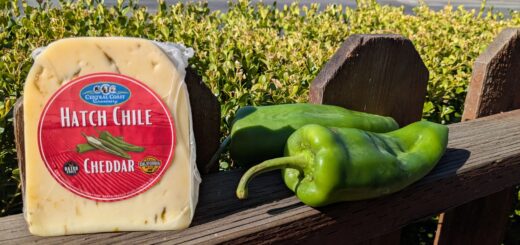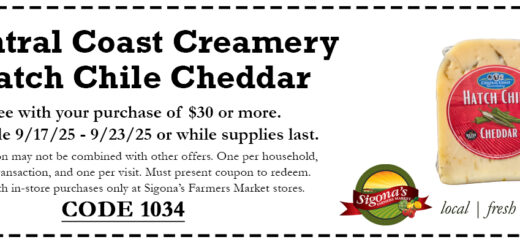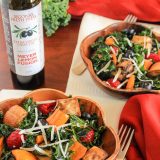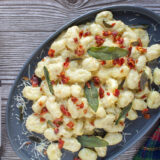Celebrate Fall with Winter Squash
Celebrate Fall with Winter Squash
Just because it’s called winter squash doesn’t mean it grows in winter. Learn more about our locally grown winter squash in season now!
By Robbie Sigona
 Just when we thought fall forgot to settle into the Bay Area, we’re greeted with chilly temperatures and rain. It definitely looks like fall at our stores — cornstalks are propped up and tethered to the poles, locally grown winter and summer squashes fill the store displays alongside decorative gourds and the floral department at our Redwood City store is full to the brim with Chinese lanterns, fall-colored leaves and other festive décor.
Just when we thought fall forgot to settle into the Bay Area, we’re greeted with chilly temperatures and rain. It definitely looks like fall at our stores — cornstalks are propped up and tethered to the poles, locally grown winter and summer squashes fill the store displays alongside decorative gourds and the floral department at our Redwood City store is full to the brim with Chinese lanterns, fall-colored leaves and other festive décor.
Summer squash, winter squash…what’s the difference?
Ever wondered why squash is categorized the way it is? While they’re both part of the Cucurbitaceae family, as are melons and even cucumbers, winter and summer squash have very difference characteristics. The difference:
- Summer Squash: varieties that fall under the summer squash category are more soft skinned and perishable; they can’t be stored for a long time and need to be eaten soon after their summer harvest – thus the name summer squash. Also, all parts of the summer squash are edible, including skin and seeds. Some examples of summer squash include yellow neck and zucchini squash.
- Winter Squash: This category includes all the hard-skinned squashes, such as Butternut, Green Danish, Kabocha and even pumpkin. Winter squashes are also harvested in late summer, but can be stored and enjoyed in the winter months, just like winter pears. The skin and seeds of winter squashes need to be removed prior to eating.
The majority of the winter squash we have in the store is grown in Fresno, but we also have some from farmers in Stockton, Hollister (Phil Foster grows our organic Butternuts) and Madera. While some of the winter varieties look more decorative than edible, they’re all great for eating and make wonderful soups, ravioli, casseroles, risottos or even lasagnas.
Some winter squash have a creamy and smooth texture when cooked, such as the Butternut, while others have a more stringy and fibrous texture, like Spaghetti and Green Danish squash. They’re versatile, too! A creamy Butternut squash soup, for one, certainly warms the bones on a crisp fall night. Then there’s one of my favorite, a tempura with Kabocha squash. It takes time but it’s worth it! We have a lot of winter squash recipes on our blog.
Here are profiles of a few of the winter squashes we carry:
–
 Green Danish (also known as Acorn): This recognizable winter squash has dark green skin with deep grooves, called furrows, and a sweet flavor. Its skin is tough and thick, so take care when preparing by gently rocking the knife or squash while cutting. Cut off the top stem and bottom first. The orange-fleshed Green Danish is lovely when stuffed and baked with either savory or sweet ingredients. The term Acorn is an older name for this variety.–
Green Danish (also known as Acorn): This recognizable winter squash has dark green skin with deep grooves, called furrows, and a sweet flavor. Its skin is tough and thick, so take care when preparing by gently rocking the knife or squash while cutting. Cut off the top stem and bottom first. The orange-fleshed Green Danish is lovely when stuffed and baked with either savory or sweet ingredients. The term Acorn is an older name for this variety.–
–
 Buttercup: This squash has an orange flesh that’s creamy and mild with a flavor similar to a sweet potato. Buttercups are round squash with dark-green skin covered in bluish-gray stripes; its distinctive characteristic is its “cap” on its blossom end. They have a particularly hard rind – a tip: position a cleaver or knife to the right of the stem, as if you were to slice in half. Gently hit where the blade and handle meet with a mallet or rolling pin to pierce the rind; continue until it splits in half.–
Buttercup: This squash has an orange flesh that’s creamy and mild with a flavor similar to a sweet potato. Buttercups are round squash with dark-green skin covered in bluish-gray stripes; its distinctive characteristic is its “cap” on its blossom end. They have a particularly hard rind – a tip: position a cleaver or knife to the right of the stem, as if you were to slice in half. Gently hit where the blade and handle meet with a mallet or rolling pin to pierce the rind; continue until it splits in half.–
–
 Butternut: Nothing says fall like Butternut puree. The Butternut squash has a tan, hard skin and an orange melt-in-your-mouth creamy flesh with a rich squash flavor. This squash is good steamed, baked, simmered or cubed and added to pasta dishes, risottos, mashed and served like mashed potatoes or pureed into soups. About one pound of Butternut squash yields about 2 cups of cooked pieces. Roasted Butternut squash tastes like a less sweet version of candied sweet potatoes and is excellent with pork and turkey. Did you know the original Butternut was introduced in 1944?–
Butternut: Nothing says fall like Butternut puree. The Butternut squash has a tan, hard skin and an orange melt-in-your-mouth creamy flesh with a rich squash flavor. This squash is good steamed, baked, simmered or cubed and added to pasta dishes, risottos, mashed and served like mashed potatoes or pureed into soups. About one pound of Butternut squash yields about 2 cups of cooked pieces. Roasted Butternut squash tastes like a less sweet version of candied sweet potatoes and is excellent with pork and turkey. Did you know the original Butternut was introduced in 1944?–
–
 Kabocha: The Kabocha (kah-BOW-cha) squash has a sweet, mild-flavored orange flesh that’s so fine-grained it’s nearly fiberless. This variety pairs particularly well with Asian flavors, such as ginger and soy sauce. Kabocha also purees beautifully into a soup. Be careful slicing through its tough rind. Follow the same slicing tips for Buttercup squash.-
Kabocha: The Kabocha (kah-BOW-cha) squash has a sweet, mild-flavored orange flesh that’s so fine-grained it’s nearly fiberless. This variety pairs particularly well with Asian flavors, such as ginger and soy sauce. Kabocha also purees beautifully into a soup. Be careful slicing through its tough rind. Follow the same slicing tips for Buttercup squash.-
–
 Spaghetti: The Spaghetti squash is classified as a winter squash, but it much different than other squash in the category. It’s named the Spaghetti squash because, when cooked, its flesh naturally separates into long Spaghetti-like strands…and yes, it serves as a good substitute for wheat- or grain-based pastas. Preparation is easy. Just bake, rake and serve with marinara: Pierce skin with a fork several times. Bake at 350F until fork-tender, about 45-60 mins for a 2 1/2 lb. squash. Cut in half immediately or it will become watery and lose its sweetness. Cool, discard seeds and then “rake” the flesh with a fork down to the skin. Serve with butter/olive oil and spices or top with marinara.–
Spaghetti: The Spaghetti squash is classified as a winter squash, but it much different than other squash in the category. It’s named the Spaghetti squash because, when cooked, its flesh naturally separates into long Spaghetti-like strands…and yes, it serves as a good substitute for wheat- or grain-based pastas. Preparation is easy. Just bake, rake and serve with marinara: Pierce skin with a fork several times. Bake at 350F until fork-tender, about 45-60 mins for a 2 1/2 lb. squash. Cut in half immediately or it will become watery and lose its sweetness. Cool, discard seeds and then “rake” the flesh with a fork down to the skin. Serve with butter/olive oil and spices or top with marinara.–
–
 Sweet Dumpling: “Cute!” is usually what we hear as customers pass by the display of green and white striped Sweet Dumpling squash. They’re almost too cute and petite to eat, but don’t pass them up…they’re perfect for stuffing or roosting and make adorable personal-sized portions. This variety has a starchy texture and a mild flavor, so load them up with seasonings and other ingredients like sausage.–
Sweet Dumpling: “Cute!” is usually what we hear as customers pass by the display of green and white striped Sweet Dumpling squash. They’re almost too cute and petite to eat, but don’t pass them up…they’re perfect for stuffing or roosting and make adorable personal-sized portions. This variety has a starchy texture and a mild flavor, so load them up with seasonings and other ingredients like sausage.–
–
 Banana: No, it doesn’t taste like a banana. This is a large, orange-colored squash with a mild flavor. We often have this one in our store pre-cut and seeded.–
Banana: No, it doesn’t taste like a banana. This is a large, orange-colored squash with a mild flavor. We often have this one in our store pre-cut and seeded.–
–
 Delicata Squash: This is one of the more decorative squashes we’ll feature now, with its yellow and green stripes with deep orange-brown speckling. It has a thinner skin than many other winter squash and doesn’t store very well. It has a creamy textured, pale yellow flesh and a mild flavor that some say is similar to the flavor of corn or sweet potatoes. The flavor is richest when baked.–
Delicata Squash: This is one of the more decorative squashes we’ll feature now, with its yellow and green stripes with deep orange-brown speckling. It has a thinner skin than many other winter squash and doesn’t store very well. It has a creamy textured, pale yellow flesh and a mild flavor that some say is similar to the flavor of corn or sweet potatoes. The flavor is richest when baked.–
–
Find recipes for winter squash varieties on our blog!
What about pumpkins?
We have more pumpkin-type squashes – A LOT more – and we’ll cover those (Jarrahdale, Turban, Cinderella, Kuri and even one called Long Island Cheese) in our next issue. Stay tuned!










